Founded 10 October 2015 | Headquarters Qamishli, Syria | |
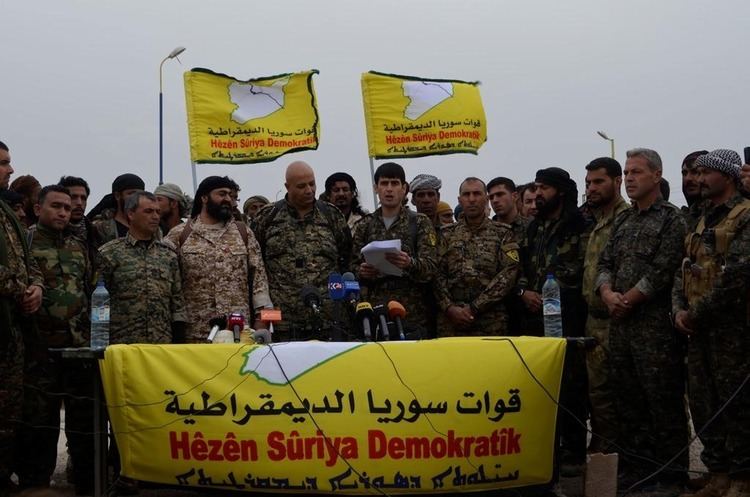 | ||
Active 10 October 2015 – present Ideology SecularismDemocracyFederalism Groups People's Protection Units (YPG)Women's Protection Units (YPJ)Anti Terror Units (YAT)Al-Baggara tribe militias Shammer tribal militiasAl-Sanadid ForcesElite ForcesSaadallah al-Jabiri BattalionArmy of RevolutionariesNorthern Sun BattalionEuphrates BrigadesJund al-Haramayn BrigadeEuphrates Martyrs BrigadeDam Martyrs BrigadeAl-Qusais BrigadeManbij Turkmen BrigadeJabhat al-AkradTel Rifaat Revolutionaries BattalionShahba Women's FrontSeljuq BrigadeMartyr Qasim Areef BattalionDivision 30 remnantsHoms Commandos Brigade99th Infantry BrigadeTribal ForcesNorthern Democratic BrigadeJabhat Thuwar al-RaqqaKatibat Harayir RaqqaRaqqa Hawks BrigadeGhanim groupMartyr Tasleem Jimmo BrigadeRaqqa Martyrs BrigadeLiwa Owais al-Qorani remnantsLiwa Suqur ar-RaqqaShoheda Hamam Turkman BrigadeFree Officers UnionShahba BrigadeLiberation Brigade factionLiwa Ahrar al-RaqqaAhrar al-Tabqa BrigadeUmanaa al-Raqqa BrigadeHarun al-Rashid BrigadeTell Abyad Revolutionaries BrigadeEuphrates Liberation BrigadeManbij Revolutionaries BattalionManbij Hawks BrigadeEuphrates Jarabulus BrigadesJarabulus Knights BattalionMartyr Zaki Jader BrigadeInstructor Jader BrigadeJuma al-Jader BrigadeGwadar Martyrs BrigadeJarabulus Armored BattalionJarabulus Hawks BrigadesFree Jarabulus BattalionAl-Bab Military Council Female BattalionAl-Bab Revolutionary FrontQebasîn Martyrs BrigadeAl-Bab Countryside Martyrs BattalionFree Arima BattalionMartyr Silo al-Rai BrigadeKieba Martyrs Brigadeal-Shaitat tribe militias Syriac Military Council (MFS)Bethnahrain Women's Protection ForcesLiwa Siqur el-BadiyeHarabiyya tribe militiasZubayd tribe militiasMilitary councilsManbij Military Councilal-Bab Military CouncilJarabulus Military CouncilDeir Ezzor Military CouncilPolitical wingSyrian Democratic Council Leaders SDF Spokesman: Talal Selo Area of operations Northern SyriaNorthern Aleppo GovernorateHasakah GovernorateRaqqa GovernorateNorthern Deir ez-Zor Governorate Strength 80,000+ fighters (as of March 2017)36,000 YPG24,000 YPJ20,000 from exclusively ethnic Arab militiasSeveral thousand from other exclusive & mixed groups | ||
Exclusive on the frontline with the syrian democratic forces fighting islamic state group
The Syrian Democratic Forces (Arabic: قوات سوريا الديمقراطية, Quwwāt Sūriyā al-Dīmuqrāṭīya, Kurdish: Hêzên Sûriya Demokratîk, Syriac: Ḥaylawotho d'Suriya Demoqraṭoyto), commonly abbreviated as SDF or QSD, are a multi-ethnic and multi-religious alliance of Kurdish, Arab, Assyrian, Armenian, Turkmen, Circassian and Chechen militias in the Syrian Civil War. The SDF is dominated in manpower and militarily led by the People's Protection Units (YPG), a mostly Kurdish militia. Founded in October 2015, the SDF states its mission as fighting to create a secular, democratic and federal Syria, along the lines of the Rojava Revolution in northern Syria. The updated December 2016 constitution of the Democratic Federal System of Northern Syria names the SDF as its official defence force.
Contents
- Exclusive on the frontline with the syrian democratic forces fighting islamic state group
- Establishment and signatory groups
- 2015
- JanuaryJune 2016
- JulyDecember 2016
- JanuaryJune 2017
- Support by the United States France and other Western nations
- Alleged internal conflicts between SDF factions
- References
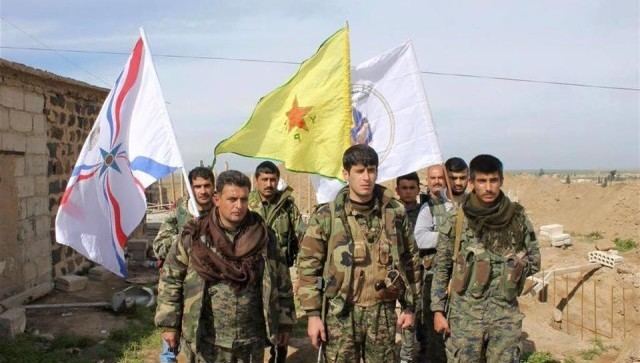
The prime opponents of the SDF and their allies are the Salafist and Islamic fundamentalist groups involved in the civil war, in particular the Islamic State of Iraq and the Levant (ISIL), Syrian opposition, al-Qaeda affiliates and their allies. The SDF has focused primarily on ISIL, successfully driving them from important strategic areas, such as Al-Hawl, Shaddadi, Tishrin Dam and Manbij.
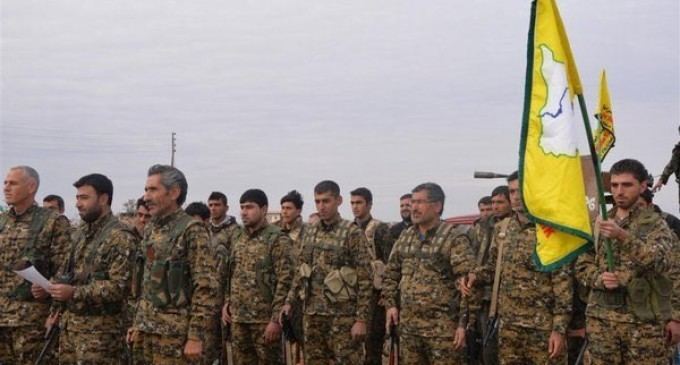
Establishment and signatory groups
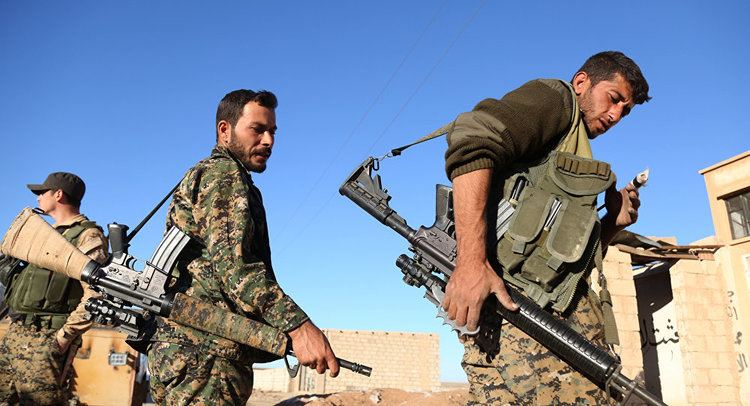
The establishment of the SDF was announced on 11 October 2015 during a press conference in al-Hasakah. The alliance built on longstanding previous cooperation between the founding partners. While the People's Protection Units (Yekîneyên Parastina Gel, YPG) and the Women's Protection Units (Yekîneyên Parastina Jin, YPJ) had been operating throughout the cantons of Rojava, the other founding partners were more geographically focused.
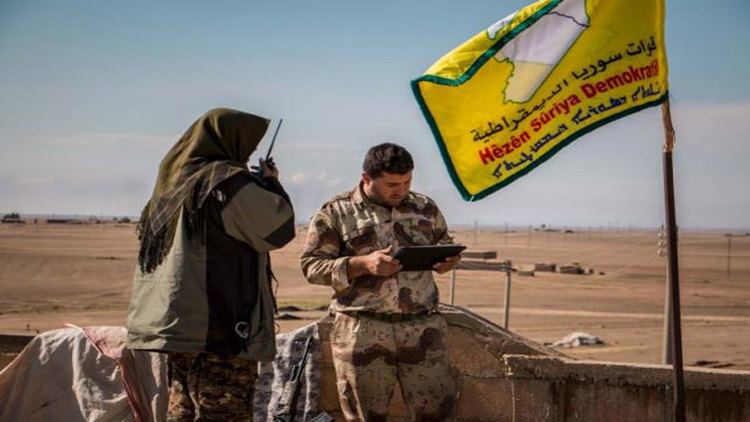
Geographically focused on Kobanî Canton were the YPG's partners in the Euphrates Volcano joint operations room, several mainstream Syrian rebel factions of the Free Syrian Army, who had helped defend the Kurdish town of Kobanî during the Siege of Kobanî. Euphrates Volcano was joined by Liwa Thuwwar al-Raqqa, expelled by the al-Nusra Front and ISIL from the city of Raqqa for being allied with the YPG, who participated in the capture of Tell Abyad from the Islamic State.
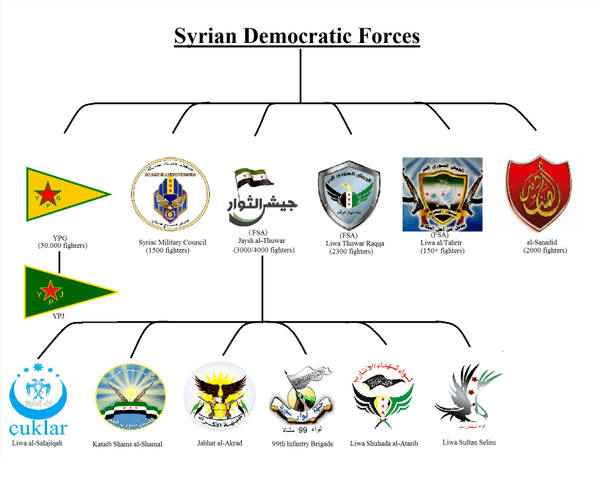
Geographically focused on Jazira Canton were the Assyrian Syriac Military Council (Mawtbo Fulhoyo Suryoyo, MFS) and the Al-Sanadid Forces of the Arab Shammar tribe, both of whom had cooperated with the YPG in fighting ISIL for years. The MFS is further politically aligned with the YPG via their shared secular ideology of democratic confederalism, which in the Assyrian community is known as the Dawronoye movement.

Geographically focused on the Shahba region was the Army of Revolutionaries (Jaysh al-Thuwar, JAT), itself an alliance of several groups of diverse ethnic and political backgrounds, who had in common that they had been rejected by the mainstream Syrian opposition for secular, anti-Islamist views and affiliations. However, most of the JAT component groups have always used the Free Syrian Army label and continue to use it.
The following groups signed the founding document:
On 10 December 2015, after a two-day conference, the SDF established its political wing, called the Syrian Democratic Council.
2015
At the time of its founding in late 2015, The Economist described the SDF as "essentially a subsidiary of the Kurdish YPG".
January–June 2016
With continuous growth in particular due to Arab groups and volunteers joining, as of March 2016 only an estimated 60% of the men and women in the SDF fighting force were ethnic Kurdish.
July–December 2016
Growth in particular of ethnic Arab, Turkmen and Assyrian participation in the SDF has since continued. In an interview on the first anniversary of the SDF's founding, spokesman Talal Silo, an ethnic Turkmen and former commander of the Seljuq Brigade, stated that "we started with 13 factions and now there are 32 factions", and that "90 percent" of the SDF growth since it began its operations were ethnic Arab. In the context of the November 2016 Northern Raqqa offensive, The Economist claimed the SDF fighting force to be composed of "about 20,000 YPG fighters and about 10,000 Arabs". The next month in December 2016, Colonel John Dorrian, the Operation Inherent Resolve spokesman, stated that the SDF contains around 45,000 fighters, of which more than 13,000 are Arabs.
January–June 2017
According to a March 2017 statement of the Spokesman for the International Coalition forces, U.S. Colonel John Dorrian, 75 percent of the SDF forces fighting in Operation Wrath of Euphrates to isolate ISIL's de-facto capital of Raqqa were Syrian Arabs, a reflection of the demographic composition of that area. "The Syrian Democratic Forces are a multi-ethnic and multi-sectarian organization, and that is one of the reasons why we're working with them and they have continued to build the Arab element of their force." Concerning the SDF in general, Lieutenant General Stephen Townsend in the same month said that "I’m seeing what is probably a pretty broad coalition of people and the Kurds may be providing the leadership, because they have a capable leader who’s stepped up to this challenge. And they are providing some of the organisational skill, but I see a large contingent about 23 to 25, 000 so far and growing, Arabs, who are marching to liberate their part of northern Syria. So, I don’t see a Kurdish state. I see a multi-cultural, multi-party, multi-ethnic, multi-sectarian Syrian region being liberated from ISIS. Over."
Support by the United States, France and other Western nations
On 12 October 2015, the Pentagon confirmed U.S. C-17 transport aircraft having dropped 100 pallets with 45 tons of arms and ammunition over SDF-controlled territory in Rojava. Polat Can, spokesman of the SDF component militia People's Protection Units (YPG), identified the freight as being "assault rifles, mortars and ammunition, but no TOW anti-tank missiles nor anti-aircraft weapons". The airdrop came only days after the Pentagon had officially abandoned its failed $500 million train-and-equip program of "moderate rebels" fighting ISIL.
During the SDF's February 2016 al-Shaddadi offensive, there were US special forces embedded with the SDF forces who coordinated airstrikes against ISIL with the SDF.
On 17 March 2016, the day after the declaration of the Federation of Northern Syria – Rojava, U.S. Defense Secretary Ashton Carter praised the SDF component militia People's Protection Units (YPG) as having "proven to be excellent partners of ours on the ground in fighting ISIL. We are grateful for that, and we intend to continue to do that, recognizing the complexities of their regional role."
During the SDF's May 2016 offensive against ISIL in Northern Raqqa, the presence of U.S. Special Forces was widely reported, and several photographs of them wearing badges of the YPG and YPJ on their uniforms circulated.
On 21 May 2016, General Joseph Votel, commanding general of U.S. Central Command, completed a secret several-hour-long trip to northern Syria to visit several locations where there were U.S. special operations forces and meet with local forces the U.S. was helping train to fight ISIL. The visit came as the first of 250 additional U.S. special operations forces were beginning to arrive in Syria to work with local forces. The commander overseeing the war in Syria, at the end of a long Saturday spent touring SDF bases, said "We do, absolutely, have to go with what we've got".
During the SDF's summer 2016 Manbij offensive against ISIL, the U.S. Air Force as well as special operation forces of several Western nations supported the SDF advance. The Syrian Observatory for Human Rights claimed that besides US special forces, German and French forces were participating. Germany officially denied the report, but France confirmed it.
After two Syrian air force SU-24´s started air strikes in Al-Hasakah, on 19 August 2016, near where coalition forces were conducting operations on the ground, coalition aircraft arrived and the Department of Defence spokesperson said that "It troubles us when we see regime air strikes in Hasakah in an area where it is well known by everybody, to include the Assad regime, that the coalition is actively engaged in operations against Isis", implicitly recognizing that elite troops are training and supporting the YPG and the Syrian Democratic Forces in the area.
During the late summer 2016 Turkish military intervention in the Syrian Civil War in the Shahba region, U.S. Special Operations Forces embedded with SDF forces in order to successfully deter Turkey and Turkish-backed jihadi rebels from attacking SDF forces south of the Sajur river. Further, the United States Department of Defense confirmed that U.S. Special Operation Forces were flying U.S. flags in the town of Tell Abyad in Kobanî Canton to deter Turkish harassment shelling or attacks against SDF forces there.
During the SDF's late summer 2016 Western al-Bab offensive against ISIL, the U.S. Air Force provided close combat support for SDF forces.
Late September 2016, the U.S. spokesman for the Combined Joint Task Force – Operation Inherent Resolve (CJTF–OIR) confirmed that the SDF, including the YPG, is also part of the "vetted forces" in the train and equip program and will be supplied with weapons. The President of Turkey, Recep Tayyip Erdoğan, condemned this and claimed that the SDF are "endangering our future".
Early October 2016, media reports highlighted construction work on another military airfield in SDF controlled territory for operations of U.S. air assets, in the vicinity of Al-Shaddadah in Jazira Canton, in addition to the two airfields the U.S. is widely reported to already co-operate there: Abu Hajar Airport in Rmelan in Jazira Canton and one airfield at the village of Septe south of Kobanî in Kobanî Canton.
Late October 2016, U.S. Army Lt. Gen. Stephen J. Townsend, the commander of the international coalition against the Islamic State of Iraq and the Levant, said that the SDF would lead the impending assault on Raqqa, ISIL's stronghold and capital, and that SDF commanders would plan the operation with advice from American and coalition troops.
From November, more than 300 U.S. Special Operations Forces were embedded to train and advise SDF fighters in the Raqqa offensive.
On 31 January 2017, the SDF received a number of armoured personnel carriers produced by ArmorGroup and supplied by the US.
In February 2017, Stephen Townsend visited Kobanî. On 25 February, the US Central Command stated that it would continue to train and equip forces of the Manbij Military Council.
During the East Aleppo offensive (February–March 2017), the US deployed troops and armored vehicles to villages near Manbij in an attempt to "deter" the skirmishes between the SDF and Turkey-backed forces west and north of Manbij.
On 31 March 2017, the US delivered 30 more Guardian armoured vehicles to the SDF for use in the Raqqa offensive.
Alleged internal conflicts between SDF factions
In November 2015, Liwa Thuwar al-Raqqa merged with the Tribal Army to form Jabhat Thuwar al-Raqqa to become part of the SDF. After some tensions between the group and the People's Protection Units (YPG), on 6 January 2016 the group allegedly issued a statement claiming it was disbanding. Later the same month, some sources claimed that the Liwa Thuwar al-Raqqa reappeared, announcing it had decided to rejoin the SDF.
Turkey has at various times tried and failed to incite tensions along ethnic lines within the SDF. At the height of one such attempts after the start of the summer 2016 Manbij offensive, Sheikh Farouk al-Mashi, an ethnic Arab former member of the Syrian parliament and designated co-chairman of the Manbij City Council, stated: "I have a Syrian ID, and Kurds have a Syrian ID. Let those people who talk against us in Turkey and Europe come here and fight ISIS. Why this distortion in media about problems between Kurds and Arabs?" Ethnic Kurdish fellow co-chairman Salih Haji Mohammed stated: "In our social contract, we say we want to have good relations with neighboring countries like Turkey. Any country that does not interfere in Manbij and our areas, we will have good relations with." A fighter gave his perspective as "we have Arabs, Kurds, nobody knows how many exactly, we all work under the SDF-forces".
In September 2016 during the Turkish military intervention in the Syrian Civil War, the leader of small SDF component group Liwa al-Tahrir, Abdul Karim Obeid, defected to the camp of Turkish-backed rebels with 20 to 100 of his men, citing opposition to alleged YPG domination of the SDF, while SDF sources suggested he was displeased with the civil administration of the Federation of Northern Syria - Rojava replacing warlordist political rule in the Free Syrian Army style. The remaining fighters stayed with the SDF.
Also In September 2016 during the Turkish military intervention, some Arab sources reported that Liwa Ahrar al-Raqqa clashed with the YPG, however two days later the Liwa Ahrar al-Raqqa's commander said that news about the clashes and defections were false, he denied that such clashes had ever happened.
In mid-November 2016, Liwa Thuwar al-Raqqa's political bureau, which has strong connections with Turkey, condemned the SDF's Raqqa offensive led by the YPG. This caused tensions between the group's political bureau, who opposes the YPG, and the overall leader and military commander of Jabhat Thuwar al-Raqqa, Abu Issa, who is allied with the YPG. Some members of Jabhat Thuwar al-Raqqa left the group and joined the SDF's Liwa Ahrar al-Raqqa in response to the tensions.
On 10 December 2016, the second phase of the Northern al-Raqqa campaign was announced, with Jabhat Thuwar al-Raqqa participating under the SDF. 2 weeks later, the Raqqa Hawks Brigade reportedly captured several Thuwar al-Raqqa military commanders and forced them to announce their defection. On 27 December, the commanders declared on video that they are still with Thuwar al-Raqqa.
